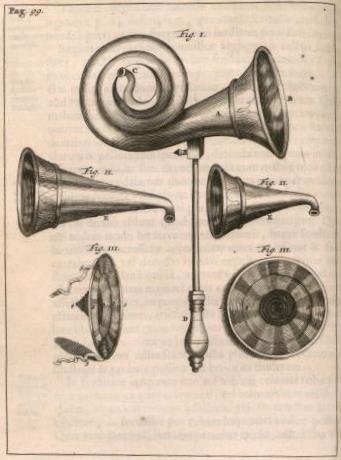
We might take it as a given that our hearing aids are hardly noticeable, can be controlled with our smart phones, and can differentiate between speech and background sound. What we might not realize, however, is that those features are the products of 400 years of experimentation, design, and development.
Even as early as 5 years ago, hearing aids could not produce the clarity of sound produced at present. To see why, let’s track the history of hearing aids—beginning today and going backwards—to see how hearing aids would have handled your hearing loss in four different years: 2016, 1985, 1940, and 1650.
2016 – Contemporary Digital Hearing Aids
It’s 2016 and you’re searching to treat your hearing loss. You launch a web browser, search for a nearby hearing care professional, complete a quick form, and schedule an appointment.
At your hearing test, your hearing is evaluated using state-of-the-art computer technology that accurately assesses your hearing. Then, with the assistance of your hearing professional, you pick out a hearing aid that accommodates your requirements from a wide selection of models.
Then, your hearing expert programs your new hearing aids to intensify only the sounds and frequencies you have difficulty hearing, leading to crystal clear sound without distortion.
If you were to tell someone in the 1980’s that this would be the process, they wouldn’t have believed it was possible.
So what did render it possible? In essence, digital technology.
For the majority of their history, there was no way for hearing aids to discern between various sound frequencies. Hearing aids would amplify all inbound sound, including background noise, producing distorted sound.
The digital revolution cleared up that challenge. With digital technology, all information can be altered, saved, and manipulated as combinations of 0’s and 1’s. Digital technology enabled hearing aids to transform sound frequencies into digital information, which could then be labeled in accordance with which sounds should be amplified (speech) and which should be suppressed (background noise).
The first all-digital hearing aid was developed in 1995, and since that time the technology has improved significantly, ultimately to incorporate wireless functionality.
1985 – Transistor Hearing Aids
Now, imagine it’s 1985 and you’re seeking to treat your hearing loss. You can forget searching for a local hearing care provider on the internet because the first commercial internet service provider won’t be established until 1989.
You’d need to use the yellow pages, depend on referrals, or drive around the neighborhood to find a hearing care practice.
After booking a consultation and having your hearing examined, your options for hearing aids are very restricted. With no microprocessor and digital technology, hearing aids were manufactured with a sequence of transistors. This adds size and higher power requirements, resulting in bigger batteries and massive hearing aids.
Additionally, without the benefit of digital technology, the hearing aid can’t distinguish between various frequencies of sound. Hearing aids receive incoming sound and the transistors behave as simple amplifiers, amplifying all sound. So if you’re in a loud area, speech recognition will be nearly impossible.
1940 – Vacuum Tube Hearing Aids
It’s 1940 and you’re interested in acquiring a hearing aid. Transistors haven’t been applied to hearing aids yet, so your options are confined to vacuum tube hearing aids.
Vacuum tubes utilize more power than transistors, so the hearing aids demand larger batteries, making the hearing aids large, heavy, and cumbersome.
And once again, without digital technology, the hearing aids can only act as simple amplification devices, making all inbound sound louder. The hearing aids can’t enrich speech and cannot filter out background noise.
1650 – Ear Trumpets
Let’s go all the way back to 1650. There’s no digital technology, no transistors, and no vacuum tubes. As a result, there is no way to transform sound into electrical currents that can be amplified.
With electrical amplification unattainable, your only alternative is mechanical amplification by concentrating and compressing sound into the ear, similar to what happens when you cup your hands around your ears.
By 1650, devices were developed that concentrated incoming sound into the ears, and these contraptions were labeled ear trumpets. They were prominent devices with a conical end that picked up sound and a narrow end that focused the sound into the ear.
This would be the only technology available to those with hearing loss for the following 250 plus years.
Let’s return to 2016. Over more than 400 years of history, hearing aids have improved from mechanical amplification devices to electrical amplification devices, from vacuum-tube-based to digital-based. They’ve come to be significantly smaller, lighter, and more efficient and affordable.
They’ve also become much better at distinguishing between various types of sound, and in amplifying only selected kinds of sound (such as amplifying speech while suppressing background noise).
Each generation of hearing aid has generated a significant improvement over the previous generation. The question is, what’s the next major benchmark in the history of hearing aids?
Will we soon be able to improve natural human hearing, rather than merely restore it?